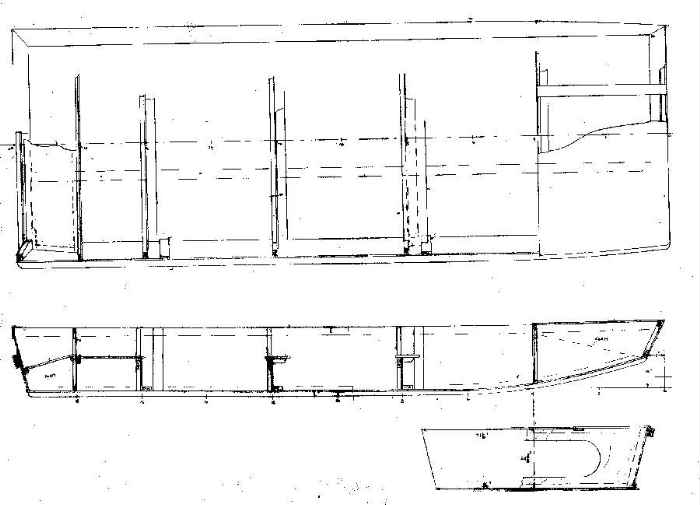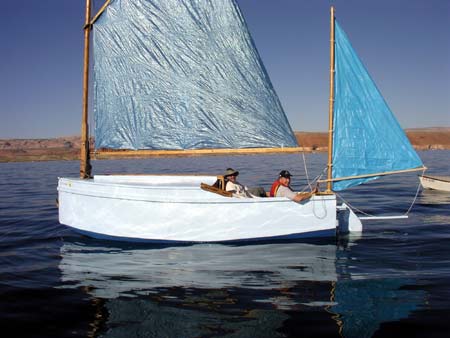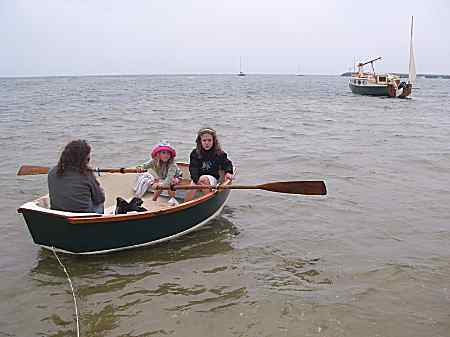
An Ozarkian project is well along in the Ozarks.
Contents:
Contact info:
Jim Michalak
118 E Randall,
Lebanon, IL 62254Send $1 for info on 20 boats.
Jim Michalak's Boat Designs
118 E Randall, Lebanon, IL 62254
A page of boat designs and essays.
(1feb08) this issue will take another look at power boat power. The 15 February issue will repeat the IMB capsize essay.
THE BOOK IS OUT!
BOATBUILDING FOR BEGINNERS (AND BEYOND)
is out now, written by me and edited by Garth Battista of Breakaway Books. You might find it at your bookstore. If not check it out at the....ON LINE CATALOG OF MY PLANS...
...which can now be found at Duckworks Magazine. You order with a shopping cart set up and pay with credit cards or by Paypal. Then Duckworks sends me an email about the order and then I send the plans right from me to you.

|
Left:
An Ozarkian project is well along in the Ozarks.
|
|
|
Powering Jon20
HERE IS A NEW DESIGN....

...A simple 20' jonboat. The bottom is a constant 6' wide and the empty hull shell might weigh 600 pounds. The hull depth is 2', the transom is shown for a short 15" shaft motor but there is a motor well in front of it which goes to the hull's top so a 15" wave over the stern won't flood anything, it would take a 24" wave to go over the bow, sides or stern.
HOW MUCH POWER WILL THIS THING TAKE???
....I go straight to a Coast Guard publication for this now. I don't guess at it. I suppose a long time ago an expert wrote the pub and you can go ahead and pick at the methods if you want. But I follow them. They don't make totaly sense in every way but what are you gonna do when giving guidelines to the public. Twenty years of dealing with the public has shown me that many highly educated people refuse to do any math at all. So you won't be bothered multiplying hull length times hull beam...so join the crowd. I don't really know if these Coast Guard max calculations have any legal value. I assume they are guidelines. But every factory boat will be placarded with such a number and I doubt if any good shop will fit more power than the recommended.
First, take overall length, 20' here. Then take max stern beam, 7.5'. Multiply to get the "factor", that's 150 for the Jon20. Then the publication has charts that conjure up the max hp allowed, in this case for a hard chined flat bottom it is about 55 hp.
MINIMUM POWER???
...The old rule that I think you can bank on is if you want to plane you need a hp for each 50 pounds afloat. Now this boat is made from a 600 pound pile of plywood and the finished bare hull out to weigh about that. Let's add say 100 pounds for a minimum motor and maybe 50 pounds of fuel and 50 pounds of general gear and maybe 200 pounds for you and you are floating 1000 pounds. That would be about the minimum weight the boat would ever be used at. Apply the old rule and you will need 20 hp to have a chance to plane it. But this is a bit boat that can easily swallow another half ton of stuff. Then you need 40 hp to plane with any margin at that heavy weight. "But," you argue, "I don't have a thousand pounds of friends." You might do fine with 30 hp.
MINIMUM MINIMUM POWER???
...The old rule about non planing power is a horse for every 500 pounds. So 4hp would suit. Why have such a big boat with such small power? I worked at a marina where they had a big aluminim jonboat, maybe a Lowe, a fine job, which they would rent to big family groups. It had no more than 10hp and would not plane so it was safe when Farmer John brought his family out to the lake once a year. Later we used the big jon as a work boat and the little motor was great. It was so big and stable that you would rather work from it than from a dock.
BUT WAIT....
...none of this says anything about how fast it goes. I think I'm getting a lot better at this than I used to be. The tricks involved were finding the speed/drag data that the Hullform (link to a free download provide way down in the links section) program provides, time spent making a gadget that measured speed/drag on my AF4. The Hullform data and the measured drag more or less agreed, much to my surprise! What didn't make sense was that it appeared that only about 1/3 of the rated power ended up as "thrust". Then a faithful reader, who did his math, said that the prop eats up the other 2/3rds of the power. Even the best props only allow you to convert half of your rated hp into thrust power.
THRUST POWER???...
Ok, horsepower is to me a measure of pushing a force at a certain speed. In the dictionary one horsepower is 33000 pounds times feet per minute. So just imagine your horse pulling on a wagon with a drag of 330 pounds at 100 feet per minute ((about 1mph) and you are watching a horsepower in action. They said the usual work horse could do that for 8 hours, go home, and come back and do it again the next day, etc., etc.. I'm thinking trained human atheletes can put out a full horse power for maybe an hour at a time, more on steroids. But most of us are good for maybe an eighth of that. I suppose a racehorse might put out ten hp for a lap.
So when you look at at drag/speed curve from Hullform you are in a general way looking at a horsepower chart. At least by going through all the apples to oranges conversions you can pick a point of the Hullform curve and say it takes X horsepower to get there. But remember that X horse power on that curve is thrust at the prop, and to get X delivered by the prop you need a powerhead that puts out about 3X. So, with that behind us, here is the Hullform guess and the Jon20 drag/speed chart:

I've got to admit I don't know for sure if I got all the apples/oranges in proper conversion (I write this an hour or so before deadline) but it all looks believable to me. The "hp" lines have already been given the 3 factor, thus the 30hp line here will actually calculate out to 10hp if you run the numbers on the chart. Such is life!
Well, it all makes sense to me. At the low end 5hp will push all of the weights to "hull speed". And it takes 20 to "plane" it with any margin in the lighter weights. At 2000 pounds 20hp won't really be enough. It looks like 25 knots will be about the max speed you could have with the Coast Guard max motor and that sounds reasonable too. Best of all, the Hullform professors have to me proven once again the validity of that "50 pounds per hp" rule.
Jon20

POWERBOAT, 20' X 7.5', 600 POUNDS EMPTY
Poor Jon20, he’s just a big dumb jonboat. 20 feet long and 6’ wide on the bottom, 7.5’ wide on the top. It takes a ton to set it 4" down in the water, and I expect the empty hull might weigh 600 pounds. So let’s say she weighs about a half ton with a minimum motor and crew and gear. If you had a long shaft motor and could build up the transom for it I think the Coast Guard type of capacity rating would be about two tons.
Interesting to design such a beast. Lots of traps I think. Almost all involve the huge flat bottom, always a problem. When the bottom goes over 4’ wide you can only cross plank with the plywood sheets. So now you need a butt joint every 4’. On Jon20 I’ve used a frame who’s wide bottom framing stick is to be the butt plate. I think it will work but it gives a frame every 4’ and some people like a boat that is more open than that. Then I ran two deep skid/stiffeners along the bottom full length in hopes the thing won’t self destruct as someone drives it into the waves head first.
Hey, that brings up another point about these things. The Coast Guard would give a low power rating to wide flat boats like this because they are nasty handlers. In spite of Jon20’s size, max rated `power would be 50 hp. And even in its lightest state it would take 20 hp to run it on plane.
Looks like eleven sheets of ½" plywood, nail and glue construction but that big wide bottom had best be armored on the outside with a good layer of glass/epoxy.
Plans Jon20 are $25 until one is built and tested.
Prototype News
Some of you may know that in addition to the one buck catalog which now contains 20 "done" boats, I offer another catalog of 20 unbuilt prototypes. The buck catalog has on its last page a list and brief description of the boats currently in the Catalog of Prototypes. That catalog also contains some articles that I wrote for Messing About In Boats and Boatbuilder magazines. The Catalog of Prototypes costs $3. The both together amount to 50 pages for $4, an offer you may have seen in Woodenboat ads. Payment must be in US funds. The banks here won't accept anything else. (I've got a little stash of foreign currency that I can admire but not spend.) I'm way too small for credit cards.
I think David Hahn's Out West Picara is the winner of the Picara race. Shown here on its first sail except there was no wind. Hopefully more later. (Not sure if a polytarp sail is suitable for a boat this heavy.

Here is a Musicbox2 I heard about through the grapevine.

This is Ted Arkey's Jukebox2 down in Sydney. Has a temporary rig and he is working on the blueprint rig.

And the Vole in New York is Garth Batista's of www.breakawaybooks.com, printer of my book and Max's book and many other fine sports books. Boat is done, shown here off Cape Cod with mothership Cormorant in background, Garth's girls are one year older. Beautiful job! I think Garth is using a small lug rig for sail, not the sharpie sprit sail shown on the plans, so I will continue to carry the design as a prototype boat.

And the Leinweber's make another prototype! This one by Sandra, an Imresboat shown here on its first outing. They are taking it on a "cruise" so more about it later.

HMMM....Just connect the dots and you will have a new Mikesboat...

And a new Down Under Blobster, as seen looking aft....

AN INDEX OF PAST ISSUES
Hullforms Download (archived copy)
Plyboats Demo Download (archived copy)
Brokeboats (archived copy)
Brian builds Roar2 (archived copy)
Herb builds AF3 (archived copy)
Herb builds RB42 (archived copy)